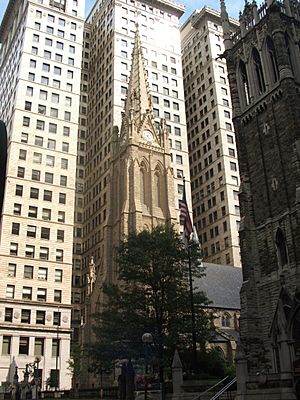Trinity Cathedral (Pittsburgh) facts for kids
Quick facts for kids Trinity Cathedral |
|
|---|---|
 |
|
| 40°26′29″N 79°59′55″W / 40.4413°N 79.9987°W | |
| Location | 322 Sixth Avenue, Downtown Pittsburgh, Pennsylvania |
| Built | 1872 |
| Architect | Gordon W. Lloyd |
| Architectural style(s) | Gothic Revival |
| Governing body | Episcopal Church |
| Designated | 1970 |
| Administration | |
| Diocese | Diocese of Pittsburgh |
Trinity Cathedral is an important Episcopal Church located in downtown Pittsburgh, Pennsylvania. It serves as the main church, or cathedral, for the Episcopal Diocese of Pittsburgh.
The beautiful Gothic building you see today was finished in 1872. It stands on land that was once a hilltop cemetery. This land was given to the church's founders by the family of William Penn, who founded Pennsylvania. The spot is special because it's on a terrace above "the point," where the Allegheny River and the Monongahela River meet to form the Ohio River. This area was a sacred burial ground for Native Americans. The churchyard at Trinity has some of the oldest marked graves west of the Atlantic Ocean. These graves belong to Native American leaders, as well as French, English, and American settlers.
Contents
The First Trinity Church: The Round Church
The very first Trinity Church wasn't built on the current spot. It was two blocks west, at the bottom of the hill. This first church was built between the 1780s and 1805. It was a brick building with eight sides, shaped like an octagon. People called it "The Round Church." It was on a small, triangular piece of land, which meant it couldn't be made bigger later on.
Trinity's Second Home: The 1824 Cathedral
In 1824, Trinity Church moved to its current location in the middle of the churchyard. This new building was one of the first Gothic style structures in Western Pennsylvania. John Henry Hopkins designed it to hold about a thousand people. The church leaders, called the Vestry, approved his plans without any changes.
The cornerstone for the new church was laid on May 1st. The building was made of brick, with a rough finish on the outside. It was wide, with balconies on three sides supported by thin columns. The ceiling was painted to look like a fancy, arched ceiling. As the church grew, they even built St. Peter as a smaller, nearby church. However, by 1869, the congregation needed an even bigger building.
The Current Trinity Cathedral Building
The cathedral you see today was designed by architect Gordon W. Lloyd between 1870 and 1871. Its outside looks like the English Gothic Style, which was popular with Episcopal churches in the mid-Victorian era. It has a single tall steeple in the middle and parts that stick out on the sides, called transepts.
Inside, there's a tall main area called the nave, with aisles on either side. Light comes in through windows high up on the walls, called clerestory windows. The walls of the nave are held up by groups of stone columns. The inside is simple, with pointed arches everywhere, similar to the work of American Gothic architect Richard Upjohn.
Some of the beautiful stained glass windows in the nave were damaged in a fire in 1967. They were replaced with new ones that look like medieval designs. All the other windows are from 1872. The stone pulpit, where the preacher stands, was built in 1922. It was designed by the famous American architect Bertram G. Goodhue.
In 2007, the outside of the cathedral was cleaned for the first time. This was done to get ready for the Episcopal Diocese of Pittsburgh's 250th anniversary. The cleaning removed a lot of dirt and soot from Pittsburgh's days as a steel-making city. This grime was actually causing acid to damage the stone on the outside of the building.
Trinity Cathedral's Role in the Diocese
In 2008, there was a disagreement within the Episcopal Church, which caused some changes. Trinity Cathedral decided to stay connected to both the main Episcopal Church and the local Diocese of Pittsburgh, even though the diocese was also going through changes. For a few years, the cathedral was led by Rev. Dr. Catherine Brall and had members from both groups involved.
This arrangement ended in 2011. The cathedral leaders voted to confirm that Trinity Cathedral would remain an Episcopal church, following its original rules from 1928.
In 2015, Bishop Dorsey W. M. McConnell brought Trinity Cathedral back to the center of the diocese's activities. He moved the main offices of the diocese from a suburb called Monroeville back to the downtown cathedral. This helped make Trinity Cathedral a central place for the diocese once again.
See also


